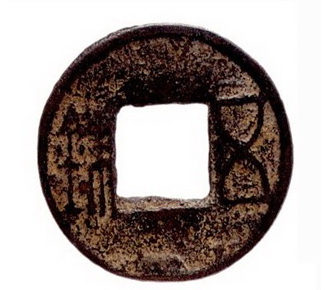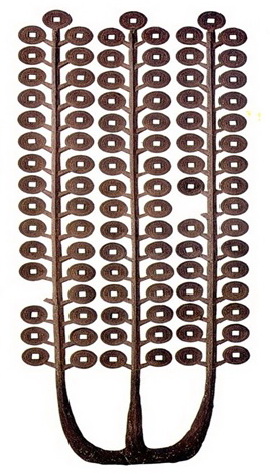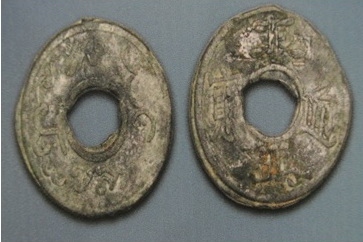During the early Rattanakosin period, in the Kingdom of Siam, each region produced money for themselves in many different designs. In particular, Southern Siam produced money called "E-pae”. It was made from tin, not only because of its availability but because of its value at that time. People used E-pae for purchasing small items or used as a form of exchange in important cities and around tin mines in southern Siam.
Around 500 BC, Chinese people started producing E-pae coins by melting and molding bronze. They were round with a hole in the middle. This lowered production costs, so many coins were easily produced and the Chinese people used them in local markets. Subsequently, the Chinese molding system spread throughout Japan, Korea, Malaya and southern Siam due to the continued migration of Chinese people in each area. In the reign of King Taksin, Chinese merchants were allowed to migrate to Thonburi and other southern cities causing the numbers of Chinese immigrants in these cities and all along the eastern sea to increase dramatically. During the reign of King Rama I to King Rama III, Siam received a high income from trading with Chinese merchants coming to Siam by ship. In addition, another factor that stimulated the Chinese people from Penang to migrate to the southern parts of Siam was the desire for tin. It had just been discovered that tin was an excellent metal for proofing iron against rust. Also during the reign of King Rama III to King Rama IV, a large number of Chinese people came to Siam and started to play important roles in commercial enterprises such as banks, rice mills, rubber plantations, mines, including government officer positions. The Chinese migrants began to settle down in the southern provinces of Siam. Some were appointed as rulers and high-ranking officials. Therefore, Chinese culture, their way of living and thinking became widely disseminated throughout the Kingdom of Siam.
Evidence excavated in the southern provinces of Siam represented trading between China and southern Siam and included Tang chinaware and Chinese coins. Tang chinaware and post-Tang chinaware were found during an excavation of an archaeological park in Yarang, Pattani. At that time, the Chinese government forbid anyone to take iron or copper outside of the country, However, shrewd merchants managed to smuggle some objects made of iron and copper, for example coins, iron pans, hoes and spades into southern Siam. These merchants then melted down the smuggled items and molded them into small pieces to be sold by their weight. Buyers then melted the pieces again and molded them into new tools or weapons.
To summarize, in the early Rattanakosin period, Chinese people came to Siam for trading and later settled down in southern Siam. They became administrative leaders and mining entrepreneurs causing Chinese culture to flow into Siam which also had an influence on coin production in southern Siam.
Coin Production in Southern Siam
Monetary evidence has been found dating from the Buddist Era, B.E 21 to the early Rattanakosin period. During the reign of King Rama II to King Rama V, the people of southern Siam produced E-pae coins made from the mixing of tin with lead, again used as a medium of small exchange. The local people called these coins "Bia”. They were round with a hole in the middle with Thai, Chinese and Arabic characters of the alphabet inscribed on them to show the names of the cities or mines where they were produced. E-pae coins were produced for rulers of Pattani, Songkhla, Patthalung, Nakorn Sri Thammarat and Chinese lead mines owners. These E-pae consisted of a blend of tin and lead together and the moulten metal was poured into a tree-shaped stone or metal molds which made the production more efficient so they were quickly able to produce many coins. The shape of the molds included the stem of various fruits which was in the same style as E-pae coins. Actually, later, all E-pae coins would be picked out of their stems and rubbed smooth to create new E-pae coins. It is believed that E-pae coins were produced for using in small exchanges around the mines or at places where the government allowed. Obviously, E-pae coins were only used locally in Siam. In the case of paying tax, people had to exchange E-pae to official currency. One of the most useful sources of documentary evidence about E-pae is the inspection report on southern Siam by Prince Panurangsri offered to King Rama V in 1884, part of which is as follows;
"…In Songkhla, Mexican coins were found along with 6 different kinds of lead coins with a hole in the middle. They were round in shape, similar to E-pae. All kinds of coins were of different sizes with inscribed characters of the alphabet and included the year. Thai baht were available, but some people had rarely used it…”
"...People in Tani used Mexican coins and tin money with a hole in the middle. Tin money was similar to E-pae. There were Arabic characters of the alphabet on the observe and the reverse. Thai baht was available but not in liquidity…”
Spending E-pae in Phattalung was mentioned in inspection report by Phra Saritpojkorn. It mentioned that "People in Phattalung use foreign money, small money and tin money called Bia. One Bia values at 400 Ath (currency)”. The tin money which was used in southern Siam, widely known as E-pae, was forbidden to be used in Bangkok.
According to evidence found in Songkhla, Pattani and Phattalung, there were various kinds of money being used in Songkhla and Pattani, for example Mexican coins, E-pae coins and Thai coins. Also, E-pae coins might have been produced in southern Siam with a design copied from Chinese E-pae.
A tree-shaped stone or metal molds
The shape of the molds included the stem of various fruits which was in the same style as E-pae coins.
Styles of E-pae Coins in Southern Siam
E-pae in Songkhla
E-pae from Songkhla was made from tin with a diameter of 30-37 mm. The rulers of Songkhla had them produced to only be used in Songkhla. Local people called them "Bia”. However, people had to exchange E-pae to official currency in the case of paying tax. There were 4 designs of E-pae in Songkhla as follows;
The first design: On the observe, the coin showed the Thai word "Songkhla” and the Arabic word "Negerisinggora” which means the "City of Songkhla”. On the reverse, there was the Chinese word "Songxiatongbo” which means "E-pae of Songkhla”.
The second design: The Thai words "Songkhla” and Culasakaraj (Minor Era) 1241/1242/1243 including the Arabic word "Negerisinggora” were inscribed on the observe. On the reverse, there was the Chinese word "Jinghintongbo” which means "E-pea brought progress”.
The third design: The observe carried the inscribed Thai word "Songkhla” and the Arabic word pronounced "Negerisinggora” and included the Chinese word "Jinghintongbo” which means "E-pae brought progress” on the reverse.
The fourth design: It was bigger and thicker than the first three designs. On the obsere, there were the Thai word "Songkhla Bia” and a small Chinese word meaning "City” with the large Chinese word around the coin "Songxiatongbomuaibiejieyi” which means "E-pae of Songkhla”.
E-pae in Songklha
E-pae in Phattalung
E-pae from Phattalung were made from tin with a diameter of 36 mm. They were produced for rulers and miners of Phattalung. They had different designs but were similar to each other. On the observe, there were Thai and Chinese words representing Phattalung and a Chinese word showing either the coin manufacturer or a word that means "E-pae of Southern Siam” on the reverse.
E-pae in Pattani
E-pae from Pattani made from tin with a diameter of 20-24 mm. There were Arabic words both on the two sides of the coins. "Khalifahtulmuhmin (Khalifmuslim)” was inscribed on the observe and "Inipitisbeelanyarayafatani” meaning "The Coin was of Pattani Raya” on the reverse. In addition, large coins showed 1261 A.H. (2324 B.E.) and the small ones showed 1301 A.H. (2424 B.E.).

E-pae in Pattani
To summarize, E-pae used in southern Siam had been influenced by E-pae from China. In the early Rattanakosin period, many Chinese people came to Siam for the purpose of trading with the local people and started living permanently in the southern parts of Siam. Inevitably, Chinese styles and ways of living were widely disseminated throughout Siam society. At that time, Chinese government officers and miners had E-pae coins produced for themselves as a medium of exchange to be used in their cities and mining areas only. Local people called it "Bia” in southern dialect. However, E-pae was not allowed to be used to pay tax, therefore, people had to exchange E-pae for official money instead. Designs of E-pae in each southern city were different with characters of the alphabets inscribed onto them in either Thai, Chinese and Arabic languages. Words on the coins represented their cities or coin manufacturers. Coin production in the early Rattanakosin period was not only in the south of Siam but also the north, northeast and east. Money used in these parts of the country was called contemporary money.
Jarinya Bunamornwit. (2015). "E-pae coins in Southern Siam". (Thai Version) Retrieved January, 2015, from Pavilion of Ragalia, Royal Decorations and Coins e-museum: http://emuseums.treasury.go.th




